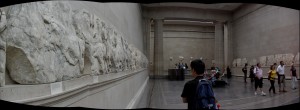Last summer, when I visited the Acropolis Museum in Greece with my family, I did not know much about the controversy surrounding the Elgin marbles. It was probably the most remarkable museum that I have seen (including those in London), with a transparent glass floor at the bottom through which I could see the walls and streets of ancient Athens, revealed by an archeological dig. As I moved up through the museum, I saw countless beautiful statues and painted vases.
However, the most strongly featured exhibit was that on the top floor: the pediments, metopes, and frieze from the Parthenon. The collection was arranged in the exact size, shape and orientation of the Parthenon. Pieces from each category of ornamentation were conspicuously missing: full size models of them were interspersed with originals, mostly marked with plaques that said “BM,” for British museum and a few that named other museums worldwide as the thieves in question. One of Greece’s goals in building the new Acropolis Museum was to make its argument for the returning of the marbles, and the museum provided many not-so-subtle hints throughout its exhibitions that they should be returned, (such as an animated video in which the Elgin’s men, dressed in black, climb the Parthenon, pick up the statues and other artifacts, and walk away with them). Indeed, it would add to the experience of seeing statues built to adorn the Parthenon, to see the Parthenon itself through the enormous glass windows that surround the top gallery in the Acropolis Museum.
Fast forward to the Parthenon exhibit in the British museum. Here, there are no windows, and the only representation of the statues outside of the British museum’s collection is on a television screen in a side gallery. Like at the Acropolis museum, the Parthenon display is set up in the shape of the Parthenon itself, with the frieze and the metopes along the perimeter, and the statues from the pediments at either end. The statues (and especially the metopes, in which relief sculptures of battles with centaurs are carved), are individually beautifully crafted and some are in excellent condition, probably both because Elgin removed the very best of the statues from the site of the Parthenon, and because some damage has come to the collection in Greece since. Despite the high quality and obvious effort on the British Museum’s part to display the marbles so that visitors can picture what they would have looked like at the Parthenon, the effect is simply not the same.
The British Museum makes a pamphlet available to visitors that outlines their argument for keeping the marbles. It explains that Elgin took the Marbles with the full permission of the Ottoman authorities in Greece at the time. However, I see this as a case of interaction between two imperial forces, not between Elgin and “Greece” as the political and cultural entity that it is today. However legal the transaction was considered by the few individuals involved, it is likely that the results would have been different if Elgin had negotiated with someone with a higher stake in Greece’s cultural identity than a foreign, occupying power. The pamphlet also claims that the marbles should stay in London because they represent the cultural heritage of the entire western world, rather than only Greece. However, what claim does Britain have to being the ideal place to display everything that makes up the cultural history of all of Europe? If the debate centers around the well being of the statues themselves, it will go nowhere, because both the British Museum and the Acropolis Museum now have more than adequate facilities to preserve and display the Elgin Marbles.
This debate seems to have no logical conclusion. However, after experiencing seeing some of the statues (and through the plaster models, the entire set), at the location of their original home, I believe that Greece has a stronger cultural and historical claim. I realize that beginning to return artifacts would not be in the British museum’s best interest. However, returning some famous artifacts (and only to those countries that can care for them), would begin to send a message to the world that Britain is willing to address the wrongs committed during its imperialist past. It would probably also free up some exhibition space for some fantastic artifacts that are currently sitting in storage.

